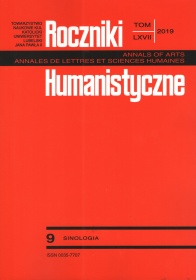The Revival of Religion in China after Mao
Abstract
The exposure of the agnostic character of Confucianism by Western sinologists has contributed to the unilateral perception of the Chinese religion as dominated by magical activity. The incompatibility of Chinese beliefs with theistic religions, which put God’s presence or the personality of the deity in the foreground, caused the conviction of sinologists has been duplicated by Western researchers of religions. As a result of such an attitude, the residents of the Middle Kingdom were treated as superstitious or even non-religious.
Republican politicians, and after them the ideologues of the Maoist CPC, who fought against the “religious superstition,” took it similarly. The persistence of “superstition” was supposed to stabilize social divisions, inhibit development and prevent the effective communication of the party with the people. However, forced atheism, contrary to the expectations of the Maoist communists, did not become a catalyst for uniting the nation or a tool for progress, but it sterilized people spiritually and as a result, instead of coexist peacefully, they sought for their own survival, also at the expense of others.
Mao died and was replaced by a pragmatic Deng. He and his successors adopted the view that the possible usefulness of religion suspends any prejudice against it. Moreover, where religion turns out to be useful in building the power of the country, it should be promoted and supported. However, this does not entail a declaration of full religious freedom. Besides, not all religions present in China are treated with equal favour. For various reasons, Chinese Buddhism is distinguished (Hàn chuán fójiào 汉传佛教). The activity of religious institutions is rationed and, in relation to various religions, accepted to a different degree.
The paper contains an analysis of the indicated and other aspects of the presence of religion in present-day China.
References
Ashiwa, Yoshiko. „Positioning Religion in Modernity: State and Buddhism in China”. W: Making Religion, Making the State. The Politics of Religion in Modern China, red. Yoshiko Ashiwa i David L. Wank, 43–73. Stanford: Stanford University Press, 2009.
Darui Long. „Humanistic Buddhism From Venerable Tai Xu to Grand Master Hsing Yun”. Hsi Lai Journal of Humanistic Buddhism 1 (2000): 58–66;
Goossaert, Vincent. „1898: The Beginning of the End for Chinese Religion?”. Journal of Asian Studies 65 (2006), 2: 307–335.
Hongyi Lai. „The Religious Revival in China”. Copenhagen Journal of Asian Studies 18 (2003): 40–64.
Hu Shih. The Chinese Renaissance. Chicago: The University of Chicago Press, 1934.
Hyung-yok Ip. „Buddhist Activism and Chinese Modernity”. Journal of Global Buddhism 10 (2009): 145–192.
Johnson, Ian. The Souls of China: The Return of Religion after Mao. London: Penguin Books, 2017.
Laliberté, André. „Buddhist Revival under State Watch”. Journal of Current Chinese Affairs 40 (2011), 2: 107–134.
Lambert, Tony. „The Present Religious Policy of the Chinese Communist Party”. Religion, State & Society 29 (2001), 2: 121-129. DOI: https://doi.org/10.1080/09637490120074800.
Overmyer, Daniel L. „Alternatives: Popular Religious Sects in Chinese Society”. Modern China 7 (1981), 2 (Apr.): 153–190.
Overmyer, Daniel L. „Religion in China Today: Introduction”. The China Quarterly 2003, No. 174 (Jun.): 307–316.
MacInnis, Daniel E. Religion in China Today: Policy and Practice. Maryknoll, N.Y.: Orbis Books, 1989
MacInnis, Daniel E.: „Secularism and Religion in China: Problem of Transcendence”. W: Contemporary Chinese Philosophy, red. Frederick J. Adelmann, 117–133. The Hague: Martinus Nijhoff Publishers, 1982.
Pittman, Don Alvin. Toward a Modern Chinese Buddhism: Taixu’s Reforms. Honolulu: University of Hawai Press, 2001.
Potter, Pitman B. „Belief in Control: Regulation of Religion in China”. The China Quarterly 2003, No. 174 (Jun.): 317–337.
Rapp, John A. Daoism and Anarchism. Critiques of State Autonomy in Ancient and Modern China. London, New York: Continuum-Bloomsbury, 2012.
Soothill, W. E. The Three religions of China. London: Hodder and Stoughton, 1913.
Suzuki Shūji. „Religion (shūkyō) and Freedom (jiyū)”. W: The Emergence of the Modern Sino-Japanese Lexicon. Seven Studies, red. Joshua A. Fogel, 81–112. Leiden: Brill, 2015.
Tarocco, Francesca. „Technologies of Salvation: (Re)locating Chinese Buddhism in the Digital Age”. Journal of Global Buddhism 18 (2017): 155-175. DOI: http://dx.doi.org/10.5281/ zenodo.1284254.
Veidlinger, Daniel. „Introduction”. W: Buddhism, the Internet and Digital Media. The Pixel in the Lotus, red. Gregory Price Grieve i Daniel Veidlinger. New York, London: Routledge, 2015.
Yang, Ching Kun. Religion in Chinese Society. A Study of Contemporary Social Functions of Religion and Some of their Historical Factors. Berkeley: University of California Press, 1961.
Yu, Anthony C. State and Religion in China. Historical and Textual Perspectives. Chicago, La Salle: Open Court, 2005.
Copyright (c) 2019 Roczniki Humanistyczne

This work is licensed under a Creative Commons Attribution-NonCommercial-NoDerivatives 4.0 International License.





